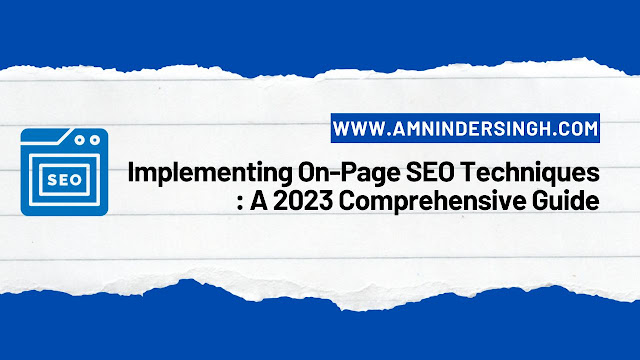In the world of digital marketing, search engine optimization (SEO) plays a pivotal role in driving organic traffic to your website. One crucial aspect of SEO is on-page optimization, which involves optimizing individual web pages to improve their visibility and ranking in search engine results pages (SERPs).
This guide will walk you through the key on-page SEO techniques that can help you boost your website’s search engine rankings and attract more organic traffic.
Understanding On-Page SEO
On-page SEO refers to the optimization of individual web pages to enhance their search engine rankings and improve their relevance to specific keywords or topics.
Effective on-page SEO techniques make your content more appealing to both search engines and users, resulting in higher organic traffic and better user experiences.
Keyword Research and Selection
Keyword research is the foundation of on-page SEO. Identify relevant keywords and phrases that your target audience is likely to use when searching for content related to your website.
Use keyword research tools like Google Keyword Planner, SEMrush, or Ahrefs to discover valuable keywords with high search volume and low competition.
On-Page SEO Best Practices
a. Title Tags
Title tags are the clickable headlines displayed in search engine results.
Optimize your title tags by including your primary keyword near the beginning and creating engaging, descriptive titles that encourage clicks.
b. Meta Descriptions
Meta descriptions provide a brief summary of your page’s content. Craft compelling meta descriptions that incorporate keywords naturally while enticing users to click on your link.
c. Header Tags (H1, H2, H3, etc.)
Header tags structure your content and indicate its hierarchy.
Use H1 tags for main headings and H2, H3, etc., for subheadings. Include relevant keywords in these tags to improve SEO.
d. URL Structure
Create clean and readable URLs that incorporate keywords where relevant. Avoid using excessive numbers, symbols, or random characters in your URLs.
e. Content Optimization
In content optimization, make sure you produce high-quality, informative, and engaging content. You are supposed to incorporate relevant keywords naturally and avoid keyword stuffing. Maintain a good balance between text and multimedia elements for all the pages.
f. Image Optimization
In image optimization, you need to optimize images by compressing them for faster loading times and adding descriptive alt text. Use filenames that reflect the image’s content and relevance to your page.
g. Internal Linking
Link to other relevant pages within your website to improve navigation and distribute link equity.
Ensure anchor text is descriptive and includes keywords when appropriate.
h. Mobile-Friendly Design
Create a responsive design that adapts to various screen sizes. Google prioritizes mobile-friendly websites in its rankings.
Technical SEO Considerations
a. Page Speed Optimization
Fast-loading pages improve user experience and search rankings. Minimize server response times, leverage browser caching, and optimize images and scripts.
b. XML Sitemaps
Generate XML sitemaps to help search engines index your pages efficiently. Submit them to search engine webmaster tools.
For blogger, you can use tools like labnol to generate blogger sitemaps.
For wordpress, you can use plugins like Rankmath or Yoast SEO to generate XML sitemaps automatically.
c. Schema Markup
Use schema markup to provide structured data to search engines, enhancing the visibility of rich snippets in SERPs.
You can generate schema markup with the help of Merkle website for free for blogger.
For WordPress, SEO plugins like Rankmath or Yoast SEO can help you generate schema markup for your pages faster.
d. Canonical URLs
Avoid duplicate content issues by setting canonical URLs, indicating the preferred version of a page.
e. HTTPS Encryption
Secure your website with HTTPS to boost user trust and improve SEO. Google considers HTTPS a ranking factor.
5. User Experience and SEO
a. User-Friendly Navigation
Simplify your website’s navigation to help users find what they need quickly. Logical menus and a well-organized site structure are essential.
b. Responsive Design
Ensure your website looks and functions well on all devices, including smartphones and tablets. A good tool to check for responsive design for your website is ‘Responsinator‘.
c. Mobile Optimization
Optimize for mobile users, as an increasing number of searches occur on mobile devices. Focus on mobile page speed and usability. You can check mobile-friendliness of any website on Google’s Mobile-friendly Test page.
d. Page Readability
Use legible fonts, appropriate font sizes, and adequate line spacing to enhance content readability. A good Google font for your website text is ‘Nunito’.
e. Avoiding Intrusive Interstitials
Avoid pop-ups and interstitials that obstruct the user experience, especially on mobile devices.
Monitoring and Measuring On-Page SEO
Use tools like Google Analytics, Google Search Console, and SEO platforms to track your on-page SEO performance.
Monitor keyword rankings, organic traffic, click-through rates, and user engagement metrics.
Regularly analyze and refine your SEO strategy based on the data.
Complete Guide to Implement On-Page SEO Techniques : Conclusion
Implementing on-page SEO techniques is crucial for digital marketing success. By understanding and applying these best practices, you can optimize your website for both search engines and users, ultimately increasing your online visibility, attracting more organic traffic, and achieving your business goals.
Stay up to date with SEO trends and algorithm updates to adapt and refine your on-page SEO strategy over time.
This article is a part of our Search Engine Optimization (SEO) Module.
Module 4: Search Engine Optimization (SEO)
4.1 Understanding Search Engine Dynamics
4.2 Implementing On-Page SEO Techniques
4.3 Mastering Off-Page SEO Strategies
4.4 Navigating Technical SEO Challenges
4.5 Leveraging SEO Tools and Analytics


